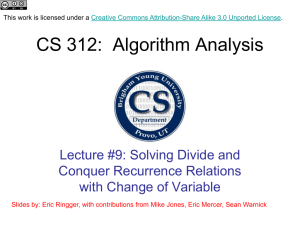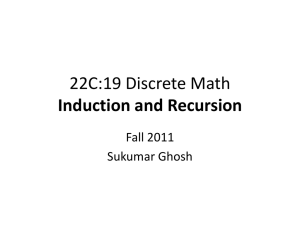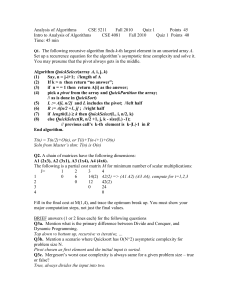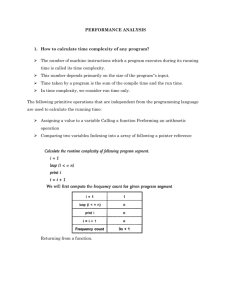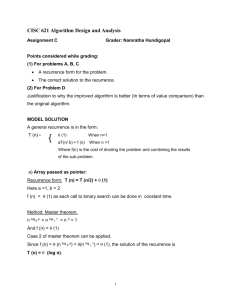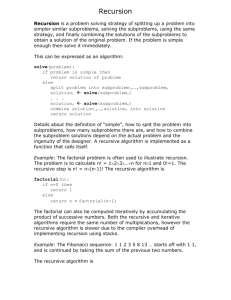03-div-con
advertisement
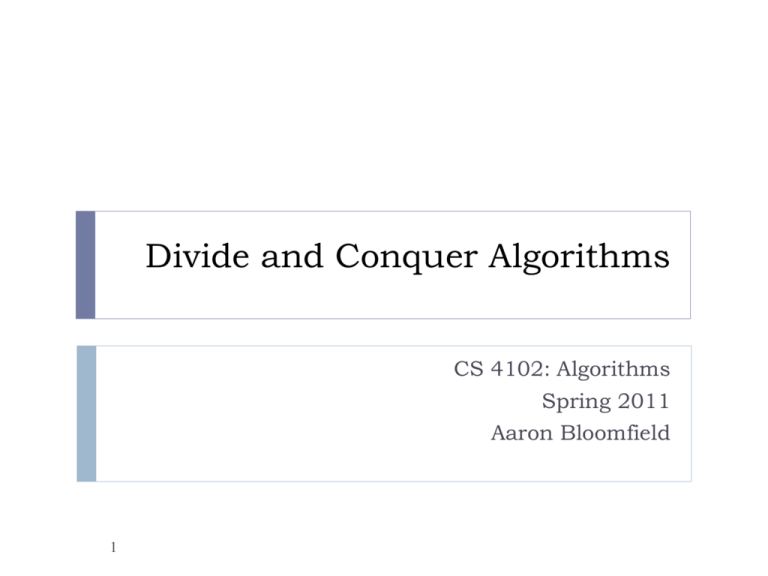
Divide and Conquer Algorithms
CS 4102: Algorithms
Spring 2011
Aaron Bloomfield
1
Recurrences and Divide & Conquer
First design strategy: Divide and Conquer
Examples…
Recursive algorithms
Counting basic operations in recursive algorithms
Solving recurrence relations
By iteration method
Recursion trees (quick view)
The “Main” and “Master” Theorems
Mergesort
Trominos
2
Recursion
3
Recursion: Basic Concepts and Review
Recursive definitions in mathematics
Factorial: n! = n (n-1)! and 0! = 1! = 1
Fibonacci numbers:
F(0) = F(1) = 1
F(n) = F(n-1) + F(n-2) for n > 1
Note base case
In programming, recursive functions can be implemented
First, check for simple solutions and solve directly
Then, solve simpler subproblem(s) by calling same function
Must make progress towards base cases
Design strategy: method99 “mental trick”
4
Designing Recursive Procedures
Think Inductively!
Converging to a base case (stopping the recursion)
identify some unit of measure (running variable)
identify base cases
How to solve p for all inputs from size 0 through 100
Assume method99 solves sub-problem all sizes 0 through 99
if p detect a case that is not base case it calls method99
method99 works and is called when:
1.The sub-problem size is less than p’s problem size
2.The sub-problem size is not below the base case
3. The sub-problem satisfies all other preconditions of method99 (which are
the same as the preconditions of p)
5
Recursion: Good or Evil?
It depends…
Sometimes recursion is an efficient design strategy,
sometimes not
Important! we can define recursively and implement nonrecursively
Note that many recursive algorithms can be re-written
non-recursively
Use an explicit stack
Remove tail-recursion (compilers often do this for you)
Consider: factorial, binary search, Fibonacci
6
Let’s consider Fibonacci carefully…
Implement Fibonacci numbers
It’s beautiful code, no?
long fib(int n) {
assert(n >= 0);
if ( n == 0 ) return 1;
if ( n == 1 ) return 1;
return fib(n-1) + fib(n-2);
}
Let’s run and time it.
Let’s trace it.
7
8
Towers of Hanoi
Ah, the legend:
9
64 golden disks
Those diligent priests
The world ends!
Towers of Hanoi
Back in the commercial
Western world…
Game invented by the
French
mathematician,
Edouard Lucas, in 1883.
Now, for only $19.95, call
now!
Your turn to design!
Write a recursive function for the Towers of Hanoi.
Number each peg: 1, 2, 3
Function signature:
hanoi ( n, source, dest, aux)
where:
n is number of disks (from the top), and
other parameters are peg values
In function body print:
Move a disk from <peg> to <peg>
Do this in pairs. Then pairs group and compare. Find
bugs, issues, etc.
Explain to each other.
Turn in one sheet with all four names.
11
Divide & Conquer
12
Divide and Conquer: A Strategy
Our first design strategy: Divide and Conquer
Often recursive, at least in definition
Strategy:
Break a problem into 1 or more smaller subproblems that are
identical in nature to the original problem
Solve these subproblems (recursively)
Combine the results for the subproblems (somehow) to
produce a solution to original problem
Note the assumption:
13
We can solve original problem given subproblems’ solutions
Design Strategy: Divide and Conquer
It is often easier to solve several small instances of a problem than
one large one.
divide the problem into smaller instances of the same problem
solve (conquer) the smaller instances recursively
combine the solutions to obtain the solution for original input
Must be able to solve one or more small inputs directly
Solve(I)
n = size(I)
if (n <= smallsize)
solution = directlySolve(I);
else
divide I into I1, …, Ik.
for each i in {1, …, k}
Si = solve(Ii);
solution = combine(S1, …, Sk);
return solution;
14
Why Divide and Conquer?
Sometimes it’s the simplest approach
Divide and Conquer is often more efficient than
“obvious” approaches
E.g. Mergesort, Quicksort
But, not necessarily efficient
Might be the same or worse than another approach
Must analyze cost
Note: divide and conquer may or may not be
implemented recursively
15
Cost for a Divide & Conquer Algorithm
Perhaps there is…
A cost for dividing into sub problems
A cost for solving each of several subproblems
A cost to combine results
So (for n > smallSize)
T(n) = D(n) + ΣT(size(Ii) + C(n))
often rewritten as:
T(n) = a T(n/b) + f(n)
These formulas are recurrence relations
16
Mergesort is Classic
Divide & Conquer
Mergesort Strategy:
17
Algorithm: Mergesort
Specification:
Input: Array E and indexes first and last, such that the elements
E[i] are defined for first <= i <= last.
Output: E[first], …, E[last] is sorted rearrangement of the same
elements
Algorithm:
def mergesort(list, first, last):
if first < last:
mid = (first+last)/2
mergesort(list, first, mid)
mergesort(list, mid+1, last)
merge(list, first, mid, last) # merge 2 halves
return
18
Exercise: Find Max and Min
Given a list of elements, find both the maximum element
and the minimum element
Obvious solution:
Consider first element to be max
Consider first element to be min
Scan linearly from 2nd to last, and update if something larger
then max or if something smaller than min
Another way:
Write a recursive function that solves this using divide and
conquer.
19
Prototype: void maxmin (list, first, last, max, min);
Base case(s)? Subproblems? How to combine results?
Recurrence Relations
20
Solving Recurrence Relations
Several methods:
Substitution method, AKA iteration method, AKA method of
backwards substitutions
Recurrence trees
We won’t see this in great detail, but a graphical view of the
recucrrence
Sometimes a picture is worth 210 words!
“Main” Theorem and the “Master” theorem
21
We’ll do this in class
Easy to find Order-Class for a number of common cases
Different variations are called different things, depending on the
source
Iteration or Substitution Method
Strategy
Write out recurrence, e.g.W(n) = W(n/2) + 1
Substitute for the recursive definition on the right-hand side by
re-applying the general formula with the smaller value
22
BTW, this is a recurrence for binary search
In other words, plug the smaller value back into the main recurrence
So now: W(n) = ( W(n/4) + 1 ) + 1
Repeat this several times and write it in a general form
(perhaps using some index i to show how often it’s repeated)
So now: W(n) = W(n/2i) + i
Substitution Method (cont’d)
So far we have: W(n) = W(n/2i) + i
This is the form after we repeat i times. How many times
can we repeat?
Use base case to solve for i
Base case is W(1) = 1
Plug this value of i back into the general recurrence:
W(n) = W(n/2i) + i = W(n/n) + lg n = lg n + 1
Note:We assume n is some power of 2, right?
23
So we set 1 = n/2i
Solve for i: so i = lg n
That’s OK. There is a theorem called the smoothness rule that states
that we’ll have the correct order-class
Examples Using the Substitution Method
Practice with the following:
Finding max and min
W(1) = 0, W(n) = 2 W(n/2) + 2
Is this better or worse than the “scanning” approach?
Mergesort
W(1) = 0, W(n) = 2 W(n/2) + n - 1
Towers of Hanoi
24
Write the recurrence. (Now, in class.)
Solve it. (At home!)
Return to Fibonacci…
Can we use the substitution method to find out the W(n)
for our recursive implementation of fib(n)?
Nope. There’s another way to solve recurrence, which we
won’t do in this class
linear
recurrence
with
constant
F(n) = (1 / sqrt(5) ) n rounded to nearest int, where is the Golden
Ratio, about 1.618
Isn’t this (1), whereas a loop is (n)? (Just punch buttons on
my calculator!)
25
second-order
This method allows us to calculate F(n) “directly”:
homogenous
coefficients
Without a table or a calculator, finding n is linear (just like finding
F(n) with a loop)
Evaluate recursive equation
using Recursion Tree
Evaluate: T(n) = T(n/2) + T(n/2) + n
Work copy:T(k) = T(k/2) + T(k/2) + k
For k=n/2, T(n/2) = T(n/4) + T(n/4) + (n/2)
[size| non-recursive cost]
26
Fibonacci upper bound
Fibonacci recurrence:
We’ll upper bound it by using:
F(n) = F(n-1) + F(n-2)
F(0) = F(1) = 1
F(n) = 2 F(n-1)
Since F(n-1) > F(n-2)
This is easier to solve via the iteration method
27
Recursion Tree: Total Cost
To evaluate the total cost of the recursion tree
Determine the maximum depth of the recursion tree:
sum all the non-recursive costs of all nodes
= Sum (rowSum(cost of all nodes at the same depth))
For our example, at tree depth d the size parameter is n/(2d)
the size parameter converging to base case, i.e. case 1
such that, n/(2d) = 1,
d = lg(n)
The rowSum for each row is n
Therefore, the total cost,T(n) = n lg(n)
28
The Master Theorem
Given: a divide and conquer algorithm
An algorithm that divides the problem of size n into a
subproblems, each of size n/b
Let the cost of each stage (i.e., the work to divide the problem
+ combine solved subproblems) be described by the function
f(n)
Then, the Master Theorem gives us a cookbook for the
algorithm’s running time
29
Some textbooks has a simpler version they call the “Main
Recurrence Theorem”
We’ll splits it into individual parts
The Master Theorem (from Cormen)
If T(n) = aT(n/b) + f(n)
Then three common cases based on how quickly f(n)
grows
then let k = lg a / lg b = logb a (critical exponent)
If f(n) O(nk-) for some positive , then T(n) (nk)
If f(n) (nk) then T(n) ( f(n) log(n) ) = (nk log(n))
If f(n) (nk-) for some positive , and f(n) O(nk+) for
some positive >= , then T(n) (f(n))
Note: none of these cases may apply
30
The Main Recurrence Theorem
A somewhat simpler version of the master theorem
If T(n) = aT(n/b) + f(n) and f(n) = (nk)
Cases for exact bound:
1.
2.
3.
T(n) (nk)
T(n) ( nk log(n) )
T(n) (nE) where E=logb(a)
if a < bk
if a = bk
if a > bk
Note f(n) is polynomial
31
This is less general than earlier Master Theorem
Using these two methods
T(n) = 9T(n/3) + n
Main Recurrence Theorem
A = 9, b = 3, f(n) = n
f(n) = n = n1, thus k=1
a ? bk
9 > 31, so (nE) where E=log3(9) = 2, (n2)
Master Theorem
k = lg 9 / lg 3 = log3 9 = 2
Since f(n) = O(nlog3 9 - ), where =1, case 1 applies:
T(n) (nE)
32
Thus the solution is T(n) = (n2) since E=2
Problems to Try
Can you use a theorem on these?
Can you successfully use the iteration method?
Assume T(1) = 0
T(n) = T(n/2) + lg n
T(n) = T(n/2) + n
T(n) = 2T(n/2) + n (like Mergesort)
T(n) = 2T(n/2) + n lg n
33
Common Forms of Recurrence Equations
Recognize these:
Divide and conquer
T(n) = bT(n/c) + f(n)
Chip and conquer:
T(n) = T(n-c) + f(n)
Note: One sub-problem of lesser cost!
Running time is n*f(n)
Chip and Be Conquered:
T(n) = b T(n-c) + f(n) where b > 1
34
Solve through iteration or main/master theorems
Like Towers of Hanoi
Back to Towers of Hanoi
Recurrence:
W(1) = 1;
W(n) = 2 W(n-1) +1
Closed form solution:
W(n) = 2n – 1
Original “legend” says the monks moves 64 golden disks
35
And then the world ends! (Uh oh.)
That’s 18,446,744,073,709,551,615 moves!
If one move per second, day and
580 billion years
Whew, that’s a relief!
night,
then
Closest Pairs
36
Problem: Find Closest Pair of Points
Given a set of points in 2-space, find a pair that has the
minimum distance between them
Distance is Euclidean distance
A computational geometry problem…
And other applications where distance is some similarity
measure
Pattern recognition problems
37
Items identified by a vector of scores
Graphics
VLSI
Etc.
Obvious Solution: Closest Pair of Points
For the complete set of n(n-1)/2 pairings, calculate the
distances and keep the smallest
38
(n2)
An aside: k Nearest Neighbors problem
How to find the “k nearest neighbors” of a given point X?
39
Pattern recognition problem
All points belong to a category, say “cancer risk” and “not at
risk”.
Each point has a vector of size n containing values for some set
of features
Given an new unclassified point, find out which category it is
most like
Find its k nearest neighbors and use their classifications to
decide (i.e. they “vote”)
If k=1 then this is the closest point problem for n=2
Solving k-NN problem
Obvious solution:
Calculate distance from X to all other points
Store in a list, sort the list, choose the k smallest
Better solution, better data structure? (think back to
CS2150)
40
Keep a max-heap with the k smallest values seen so far
Calculate distance from X to the next point
If smaller than the heap’s root, remove the root and insert that
point into the heap
Why a max-heap?
Back to Closest Pairs
How’s it work?
See class notes (done on board), or the textbook
41
Summary of the Algorithm
Strategy:
Sort points by x-coordinate
Divide into two halves along x-coordinate.
Get closest pair in first-half, closest-pair in second-half. Let
be value of the closest of these two.
Gather points in strip of width 2 into an array Sy
For each point in Sy
42
In recursion, if 3 points or fewer, solve directly to find closest pair.
Look at the next 7 (or 15) points in Sy to see if they closer than
Analysis: Closest Pairs
What are we counting exactly?
(1) Sort all points by x-coordinate: Θ(n lgn)
(2) Recurrence: T(3) = k
T(n) = 2T(n/2) + cn
Several parts of this algorithm. No single basic-operation for
the whole thing
Checking the strip is clearly O(n)
This is Case 2 of the Main Theorem, so the recursive part
is also (n log n)
43
T(n) = 2T(n/2) + n + c
Mergesort
44
New Problem: Sorting a Sequence
The problem:
Given a sequence a0 … an
reorder them into a permutation a’0 … a’n
such that a’i <= a’i+1 for all pairs
Specifically, this is sorting in non-descending order…
Basic operation
Comparison of keys. Why?
However, swapping items is often expensive
45
Controls execution, so total operations often proportional
Important for definition of a solution
Often an expensive operation (say, large strings are keys)
We can apply same techniques to count swapping in a separate
analysis
Why Do We Study Sorting?
An important problem, often needed
Often users want items in some order
Required to make many other algorithms work well. Example:
For searching on sorted data by comparing keys, optimal
solutions require (log n) comparisons using binary search
And, for the study of algorithms…
46
A history of solutions
Illustrates various design strategies and data structures
Illustrates analysis methods
Can prove something about optimality
Mergesort is Classic Divide & Conquer
Strategy
47
Algorithm: Mergesort
Specification:
Input: Array list and indexes first, and Last, such that the
elements list[i] are defined for first <= i <= last.
Output: list[first], …, list[last] is sorted rearrangement of the
same elements
Algorithm:
def mergesort(list, first, last):
if first < last:
mid = (first+last)/2
mergesort(list, first, mid)
mergesort(list, mid+1, last)
merge(list, first, mid, last)
return
48
Exercise: Trace Mergesort Execution
Can
you
trace
MergeSort()
on
A = {8, 3, 2, 9, 7, 1, 5, 4};
49
this
list?
Efficiency of Mergesort
Cost to divide in half? No comparisons
Two subproblems: each size n/2
Combining results? What is the cost of merging two lists
of size n/2
Soon we’ll see it’s n-1 in the worst-case
Recurrence relation:
W(1) = 0
W(n) = 2 W(n/2)+ merge(n)
= 2 W(n/2) + n-1
You can now show that this W(n) (n log n)
50
Merging Sorted Sequences
Problem:
Given two sequences A and B sorted in non-decreasing order,
merge them to create one sorted sequence C
Input size: C has n items, and A and B each have n/2
Strategy:
51
determine the first item in C: It is the minimum between the
first items of A and B. Suppose it is the first items of A. Then,
rest of C consisting of merging rest of A with B.
Algorithm: Merge
Merge(A, B, C) // where A, B, and C are sequences
if (A is empty)
else if (B is empty)
first of C = first of A
merge (rest of A, B, rest of C)
else
rest of C = rest of A
else if (first of A <= first of B)
rest of C = rest of B
first of C = first of B
merge (A, rest of B, rest of C)
return
W(n) = n – 1
52
More on Merge, Sorting,…
See textbook for a more detailed code for merge
In-place merge is possible
Python example available soon on the course website
What’s “in-place” mean?
Space usage is constant, or (1)
When is a sort stable?
53
If duplicate keys, their relative order is the same after sorting as it was
before
Sometimes this is important for an application
Why is mergesort stable?
Trominoes
54
Next Example: Trominos
Tiling problems
For us, a game: Trominos
In “real” life: serious tiling problems regarding component
layout on VLSI chips
Definitions
Tromino
A deficient board
n x n where n = 2k
exactly one square missing
Problem statement:
Given a deficient board, tile it with trominos
55
Exact covering, no overlap
Trominos: Playing the Game, Strategy
Java app for Trominos:
http://www3.amherst.edu/~nstarr/puzzle.html
How can we approach this problem using Divide and
Conquer?
Small solutions: Can we solve them directly?
Yes: 2 x 2 board
Next larger problem: 4 x 4 board
Hmm, need to divide it
Four 2 x 2 boards
Only one of these four has the missing square
56
Solve it directly!
What about the other three?
Trominos: Key to the Solution
Place one tromino where three 2 x 2 boards connect
You now have three 2 x 2 deficient boards
Solve directly!
General solution for deficient board of size n
57
Divide into four boards
Identify the smaller board that has the removed tile
Place one tromino that covers the corner of the other three
Now recursively process all four deficient boards
Don’t forget! First, check for n==2
Input Parameters: n, a power of 2 (the board size);
the location L of the missing square
Output Parameters: None
tile(n,L) {
if (n == 2) {
// the board is a right tromino T
tile with T
return
}
divide the board into four n/2 × n/2 subboards
place one tromino as in Figure 5.1.4(b)
// each of the 1 × 1 squares in this tromino
// is considered as missing
let m1,m2,m3,m4 be the locations of the missing squares
tile(n/2,m1)
tile(n/2,m2)
tile(n/2,m3)
tile(n/2,m4)
}
58
Trominos: Analysis
What do we count? What’s the basic operation?
Conclusion: we can just count how many trominos are
placed
How many fit on a n x n board?
Note we place a tromino and it stays put
No loops or conditionals other than placing a tile
Assume placing or drawing a tromino is constant
Assume that finding which subproblem has the missing tile is
constant
(n2 – 1) / 3
Do you think this optimal?
59
Matrix Multiplication
60
Matrix Multiplication
We known how to multiply matrices for a long time!
But matrices and can be broken up into sub-matrices and
operated on
If we count how many arithmetic operations, then it takes n3
multiplications and n3 additions
So (n3) is “normal”, but could we do better.
Hard to see how….
Leads to recursive way to multiply matrices
One approach: T(n) = 8T(n/2) + n2
61
That’s still (nlog28) = (n3)
Matrix Multiplication
In 1969, Strassen found a faster approach
Mathematicians were surprised
Consider two matrices:
a11 a12
A
a21 a22
b11 b12
B
b21 b22
Their product is:
a11b11 a12b21 a11b12 a12b22
AB
a21b11 a22b21 a21b12 a22b22
62
Original running time
Splitting two n-size matrices along two dimensions each
leads to 8 sub-problems
And it takes 4(n/2)2 = n2 additions to combine them
Recurrence:T(n) = 8T(n/2) + n2
Running time is (nlog28) = (n3)
63
Strassen’s Algorithm
Compute:
Then the product is:
q1 (a11 a22 ) * (b11 b22 )
q2 (a21 a22 ) * b11
q3 a11 * (b12 b22 )
q4 a22 * (b21 b11 )
q5 (a11 a12 ) * b22
q6 (a21 a11 ) * (b11 b12 )
q7 (a12 a22 ) * (b21 b22 )
64
q3 q5
q1 q4 q5 q7
AB
q2 q4
q1 q3 q2 q6
a11b11 a12b21 a11b12 a12b22
a21b11 a22b21 a21b12 a22b22
Strassen’s Matrix Multiplication
Important fact (for us)
Not just a theoretical result: useful for n>50
Just needs 7 multiplications of n/2 size matrices, not 8
Also requires (n2) arithmetical operations
T(n) = 7T(n/2) + n2 = nlg7 = n2.807
Running time is (nlog27) = (n2.807)
Why? Go back and look at our theorems!
And not really time efficient for n<50
Better result later: (n2.376) by Coppersmith & Winograd
65
But the big-Theta constant is so large that to see a speedup,
you need matrices that are too large for modern day computers
to handle
Conclusion
66
Divide and Conquer: Bottom-line
Powerful technique for a wide array of problems
Don’t let a lot of “extra” work fool you:
67
Sometimes recursive pays off
But you need to know when
Algorithm analysis!
